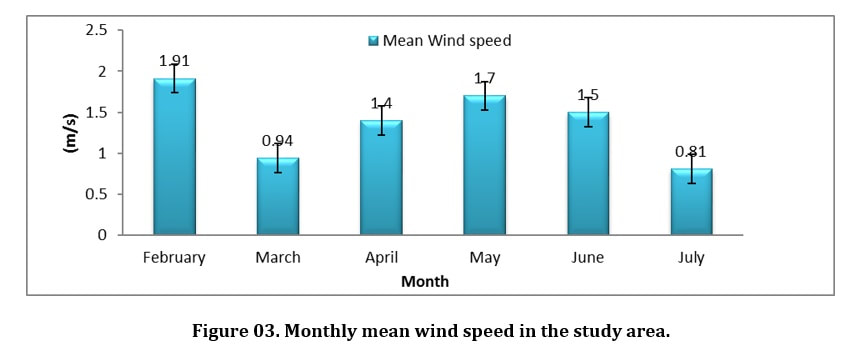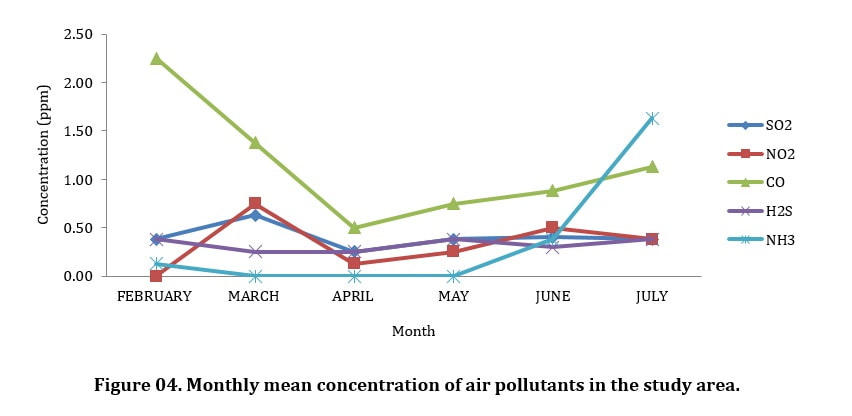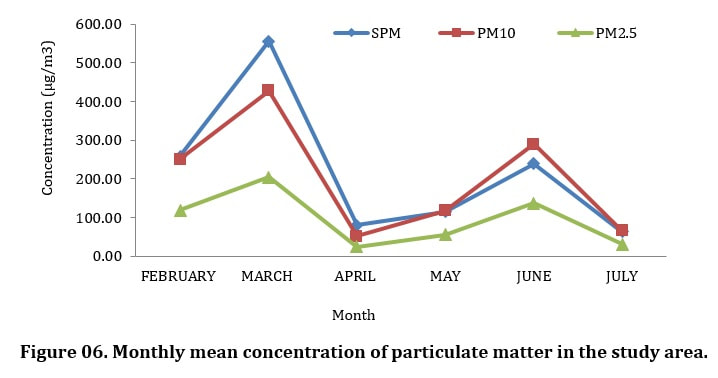J. Sci. Technol. Environ. Inform. | Volume 07, Issue 01, 500-509| https://doi.org/10.18801/jstei.070119.52
Article type: Research article, Received: 22.11.2018, Revised: 28.02.2019, Date of Publication: 14 March 2019.
Article type: Research article, Received: 22.11.2018, Revised: 28.02.2019, Date of Publication: 14 March 2019.
Assessment of air quality and its health implications on Abuja campus residence, University of port Harcourt, Nigeria
Ugbebor, J. N., Yorkor, B. and Amadi, G.
Dept. of Civil and Environmental Engineering, Faculty of Engineering, University of Port Harcourt, Nigeria.
Dept. of Civil and Environmental Engineering, Faculty of Engineering, University of Port Harcourt, Nigeria.
Abstract
This study investigated the concentrations air pollutants in the air quality of the Abuja campus business area of the University of port Harcourt. Air pollutants and meteorological parameters were monitored on monthly basis for a period of six months (February to July 2017) using suitable calibrated air quality instrument. Daily 1-hour averaging of pollutants concentrations was carried out for a period of 8 hours. SO2 showed minimum mean concentration of 0.25ppm in April and maximum mean concentration of 0.63ppm in March; NO2 showed minimum mean concentrations of 0.13ppm in April and maximum mean concentration of 0.75ppm in March; CO showed minimum mean concentrations of 0.5ppm in April and maximum mean concentration of 2.25ppm in February; H2S showed minimum mean concentration of 0.25ppm in March and April and maximum mean concentration of 0.38ppm in February, May and July; mean concentrations of CH4 ranged from 21.25ppm (minimum) in May to 32.5ppm (maximum) in February; mean concentrations of NH3 ranged from 0.13ppm (minimum) in February to 1.163ppm (maximum) in July; also mean concentrations of SPM ranged from 62.65 µg/m3 (minimum) in July to 555.5 µg/m3 (maximum) in March; mean concentrations of PM10 range between 51.75 µg/m3 (minimum) in April and 428 µg/m3 (maximum) in March; mean concentrations of PM2.5 ranged between 24.13 µg/m3 in April (minimum) and 203.63 µg/m3 (maximum) in March. The study revealed that the air quality in the Business Area of Abuja Campus of the University of Port Harcourt is polluted and poses a major risk to human health. Long-time exposure may exacerbate cases of respiratory and cardiovascular problems among the exposed population.
Key Words
Air quality, Business area, Campus, University, Pollutants, Pollution rose and Health
This study investigated the concentrations air pollutants in the air quality of the Abuja campus business area of the University of port Harcourt. Air pollutants and meteorological parameters were monitored on monthly basis for a period of six months (February to July 2017) using suitable calibrated air quality instrument. Daily 1-hour averaging of pollutants concentrations was carried out for a period of 8 hours. SO2 showed minimum mean concentration of 0.25ppm in April and maximum mean concentration of 0.63ppm in March; NO2 showed minimum mean concentrations of 0.13ppm in April and maximum mean concentration of 0.75ppm in March; CO showed minimum mean concentrations of 0.5ppm in April and maximum mean concentration of 2.25ppm in February; H2S showed minimum mean concentration of 0.25ppm in March and April and maximum mean concentration of 0.38ppm in February, May and July; mean concentrations of CH4 ranged from 21.25ppm (minimum) in May to 32.5ppm (maximum) in February; mean concentrations of NH3 ranged from 0.13ppm (minimum) in February to 1.163ppm (maximum) in July; also mean concentrations of SPM ranged from 62.65 µg/m3 (minimum) in July to 555.5 µg/m3 (maximum) in March; mean concentrations of PM10 range between 51.75 µg/m3 (minimum) in April and 428 µg/m3 (maximum) in March; mean concentrations of PM2.5 ranged between 24.13 µg/m3 in April (minimum) and 203.63 µg/m3 (maximum) in March. The study revealed that the air quality in the Business Area of Abuja Campus of the University of Port Harcourt is polluted and poses a major risk to human health. Long-time exposure may exacerbate cases of respiratory and cardiovascular problems among the exposed population.
Key Words
Air quality, Business area, Campus, University, Pollutants, Pollution rose and Health
Article Full-Text PDF
| 52.01.07.2019_assessment_of_air_quality_and_its_health_implications_on_abuja_campus_residence_university_of_port_harcourt_nigeria.pdf | |
| File Size: | 1157 kb |
| File Type: | |
|
Share This Article
|
|
Article Citations
MLA
Ugbebor, et al. “Assessment of air quality and its health implications on Abuja campus residence, University of port Harcourt, Nigeria.” Journal of Science, Technology and Environment Informatics 07(01) (2019): 500-509.
APA
Ugbebor, J. N., Yorkor, B. and Amadi, G. (2019). Assessment of air quality and its health implications on Abuja campus residence, University of port Harcourt, Nigeria. Journal of Science, Technology and Environment Informatics, 07(01), 500-509.
Chicago
Ugbebor, J. N., Yorkor, B. and Amadi, G. “Assessment of air quality and its health implications on Abuja campus residence, University of port Harcourt, Nigeria.” Journal of Science, Technology and Environment Informatics 07(01) (2019): 500-509.
Harvard
Ugbebor, J. N., Yorkor, B. and Amadi, G. 2019. Assessment of air quality and its health implications on Abuja campus residence, University of port Harcourt, Nigeria. Journal of Science, Technology and Environment Informatics, 07(01), pp. 500-509.
Vancouver
Ugbebor, JN, Yorkor, B and Amadi, G. Assessment of air quality and its health implications on Abuja campus residence, University of port Harcourt, Nigeria. Journal of Science, Technology and Environment Informatics. 2019 March 07(01): 500-509.
Ugbebor, et al. “Assessment of air quality and its health implications on Abuja campus residence, University of port Harcourt, Nigeria.” Journal of Science, Technology and Environment Informatics 07(01) (2019): 500-509.
APA
Ugbebor, J. N., Yorkor, B. and Amadi, G. (2019). Assessment of air quality and its health implications on Abuja campus residence, University of port Harcourt, Nigeria. Journal of Science, Technology and Environment Informatics, 07(01), 500-509.
Chicago
Ugbebor, J. N., Yorkor, B. and Amadi, G. “Assessment of air quality and its health implications on Abuja campus residence, University of port Harcourt, Nigeria.” Journal of Science, Technology and Environment Informatics 07(01) (2019): 500-509.
Harvard
Ugbebor, J. N., Yorkor, B. and Amadi, G. 2019. Assessment of air quality and its health implications on Abuja campus residence, University of port Harcourt, Nigeria. Journal of Science, Technology and Environment Informatics, 07(01), pp. 500-509.
Vancouver
Ugbebor, JN, Yorkor, B and Amadi, G. Assessment of air quality and its health implications on Abuja campus residence, University of port Harcourt, Nigeria. Journal of Science, Technology and Environment Informatics. 2019 March 07(01): 500-509.
References
- Akindejoye, E. (2018). The impact of soot to human health: an environmental analysis of the Niger Delta. Retrieved from http://csr-in-action.org/impact-of-soot-to-human-health-an-environmental-analysis-of-the-niger-delta.
- Akinfolarin, O. M. Obunwo, C. C. and Boisa, N. (2018). Air quality characteristics of emerging industrial areas in Port Harcourt, Nigeria. J. Chem Soc. Nigeria, 43(1), 7-14.
- ATSDR (1999). Sulfur Dioxide CAS # 7446-09-5. Agency for toxic substances and disease registry tox FAQs.
- ATSDR (2002). Nitrogen oxides (nitric oxide, nitrogen dioxide, etc.)CAS #10102-43-9 (nitric oxide); CAS #10102-44-0 (nitrogen dioxide).
- ATSDR (2004). Toxicological profile for ammonia. Atlanta, GA: U.S. Department of Health and Human Services, Public Health Service.
- ATSDR (2016). Toxicological profile for hydrogen sulfide and carbonyl sulfide produced by the agency for toxic substances and disease registry, U.S. Department of Health and Human Services, Public Health Service in Atlanta, GA.
- Carslaw, D. C. (2015). The open-air manual-open-source tools for analyzing air pollution data. Manual for version 1.1-4, King’s College London.
- Davis M. L. and Cornwell D. A. (2008). Introduction to environmental engineering. McGraw – Hill Companies, Inc; New York, 4 Ed.
- FEPA (1991): Guidelines and standards for environmental pollution control in Nigeria. Federal Environmental Protection Agency.
- Jo, J. Y. Kwon, Y. S. Lee, J. W. Park, J. S. Rho, B. H. and Won-Il Choi, W. (2013). Acute Respiratory Distress Due to Methane Inhalation. The Korean Academy of Tuberculosis and Respiratory Diseases. Retrieved from https://www.ncbi.nlm.nih.gov/pmc/articles/PMC3617131/pdf/trd-74-120.pdf.
- Khan, R. R. and Siddiqui, M. J. A. (2014). Review on effects of particulates; sulfur dioxide and nitrogen dioxide on human health. International Research Journal of Environment Sciences, 3(4), 70-73.
- Leton, T. G. (2007). Pollution control engineering -selected topic. Pearl Publishers, Port 495 Harcourt, Nigeria. pp. 97-98.
- Ogbu, K. and Nwankwo, C. A. (2017). Modelling the influence of meteorological parameters on particulate matter in Abuja campus of the University of Port Harcourt. Master degree dissertation, Department of Civil and Environmental Engineering, Faculty of Engineering, University of Port Harcourt, Nigeria.
- Osimobi, O. J. and Nwankwo, C. A. (2018). Assessment of particulate matter concentrations in a university campus in Nigeria. Journal of Environmental Studies, 4(1), pp. 1-4. https://doi.org/10.13188/2471-4879.1000024
- Rao, M. N and Rao, H. V. N. (2005). Air pollution. Tata McGraw-Hill. Publishing company 502 Limited, 22nd Reprint, New Delhi.
- Rather, P. A. Mushtaq, B. Wanganeo, A. Bhat, B. A. and Wani, M. A. (2014). Air quality of university campus and national highway No.12 at Hoshangabad Road, Bhopal, India. International Journal of Marine, Atmospheric & Earth Sciences, 2(1), 52-57.
- Renner, R. N. and Iroegbu C. C. (2017). Black soot in Port Harcourt: incidence of pathogenic microbes associated with black soot in indoor aerosols of classrooms in Port Harcourt Nigeria.
- Tawari, C. C. and Abowei, J. F. N. (2012). Air pollution in the Niger delta area of Nigeria. International Journal of Fisheries and Aquatic Sciences, 1(2), 94-117.
- Ubong, I. U. and Osaghe, I. O. (2018). “Investigation and evaluation of health hazards associated with smoke emissions from proliferation of generators in Port Harcourt Metropolis”, International Journal of Development and Sustainability, Vol. 7 No. 5, pp. 1654-1675.
- WHO (2006). Particulate matter, ozone, nitrogen dioxide and sulfur dioxide. Air Quality Guidelines Global Update 2005.
- Yakubu, O. H. (2017). Particle (soot) pollution in Port Harcourt rivers state, Nigeria-Double Air Pollution Burden? Understanding and Tackling Potential Environmental Public Health Impacts. Environments, 5, 2. https://doi.org/10.3390/environments5010002
- Yorkor, B. Leton T. G. and Ugbebor, J. N. (2017). The role of meteorology for seasonal variation in air pollution level in Eleme, Rivers State, Nigeria. Journal of Scientific Research & Reports, 17(3), 1-17. https://doi.org/10.9734/JSRR/2017/36613
© 2019 The Authors. This article is freely available for anyone to read, share, download, print, permitted for unrestricted use and build upon, provided that the original author(s) and publisher are given due credit. All Published articles are distributed under the Creative Commons Attribution 4.0 International License.
Journal of Science, Technology and Environment Informatics, EISSN 2409-7632.


